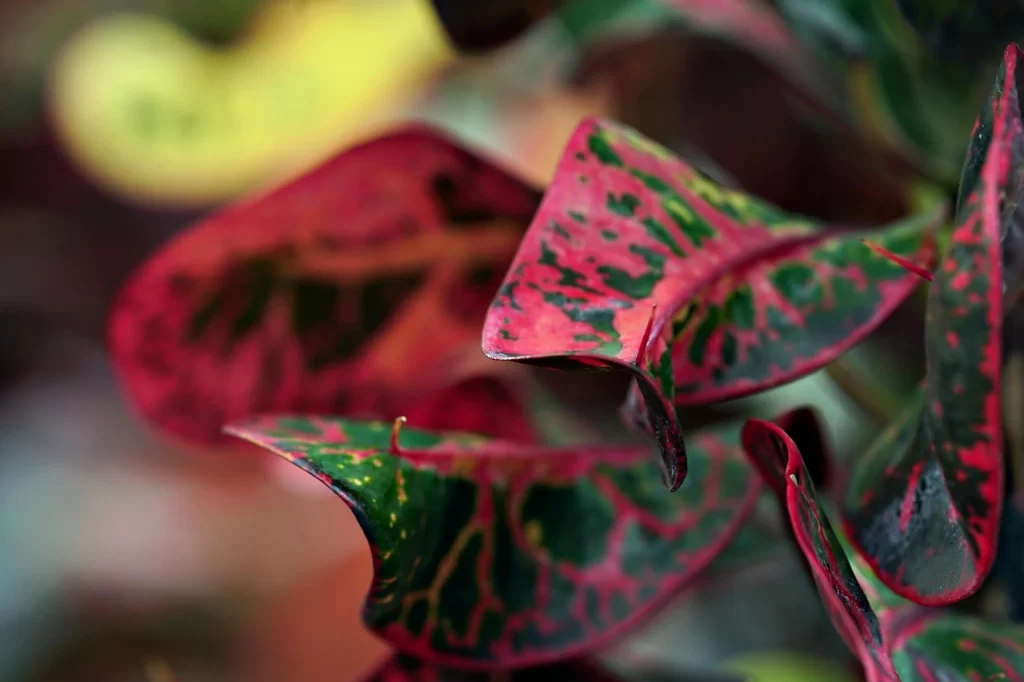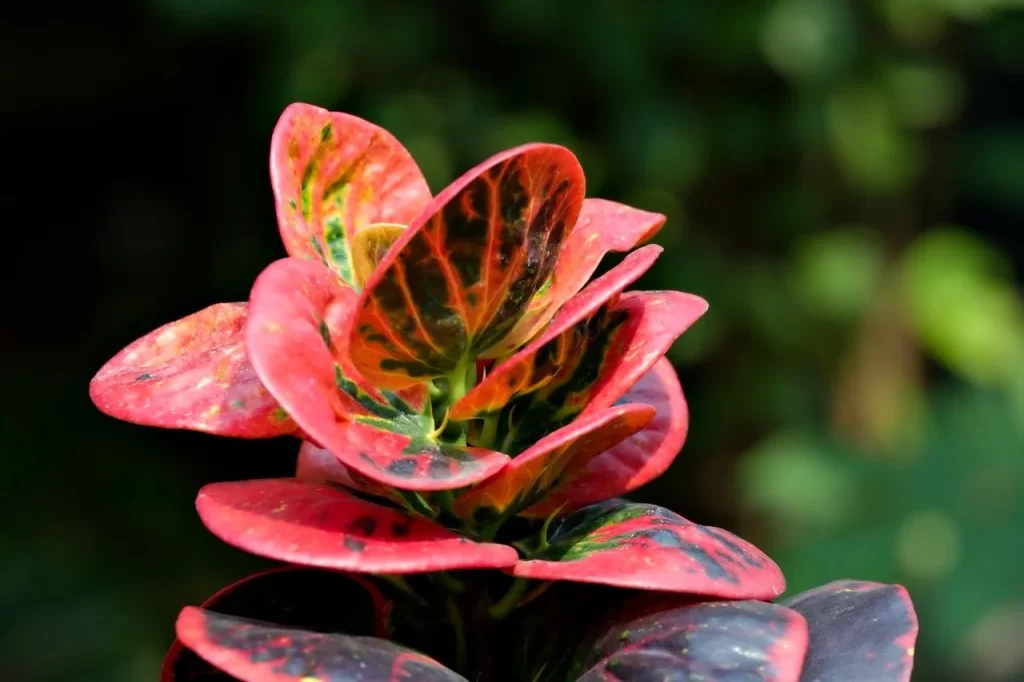Joseph’s Coat (Croton) is a popular Southeast Asian plant famous for its manageable height, making it an excellent choice for architectural spaces. Croton comes in over 200 varieties with glossy and leathery young leaves in shades of green, bronze, yellow, or red, turning into colors like gold and scarlet as they grow. However, the Croton plant is attractive and has medicinal benefits, including promoting sleep, fighting fungus, and possibly fighting cancer. Additionally, of approximately 149 recorded Croton species, 40 are used as herbal medicines to treat conditions such as intestinal worms, hypertension, diabetes, external wounds, ulcers, etc.
Read: Snake Plant Benefits: A Green Oasis for Health and Wellness

Architectural Benefits and Purpose of Use
Croton plants are versatile and are used in various architectural areas for aesthetic enhancement and functional purposes.
Landscaping – Outdoor spaces like gardens, parks, and pathways can benefit from croton plants’ vibrant colors and unique foliage textures.
Parks – Croton varieties can be planted in public parks to create visually appealing green spaces, contributing to the overall aesthetics of recreational areas.
Commercial Spaces – Crotons are suitable for adorning commercial spaces such as shopping complexes, restaurants, and hotels, providing a welcoming and visually stimulating environment for customers.
Gardens – The trailing and cascading growth habits of some Croton varieties allow them to be used in hanging baskets and vertical gardens while enhancing green walls or suspended displays.
However, homeowners often include Croton plants in their gardens as standalone ornamental plants to add color and interest to flower beds.
Indoor Decor – Croton species make excellent indoor plants, adding a touch of nature to interior spaces like offices, homes, and public buildings. However, they blossom in containers and add a touch of charm to different interior spaces.
Events – Croton plants unique foliage displays at architectural events, exhibitions, or temporary installations.
Medicinal Benefits of Croton Species
Various Croton species have therapeutic value, such as Croton cajucara, Croton celtidifolius, and Croton eluteria. The Brazilian Amazon utilizes Croton cajucara for diabetes and digestive issues, and southern Brazil operates Croton celtidifolius for inflammation. Many Croton species produce a valuable sap called “dragon’s blood,” traditionally used in wound healing. Other species, such as C. malambo and C. nepetaefolius, utilize them for traditional medicine for various ailments, showcasing the diverse medicinal properties[1]Ghosh T, et,. A Review on Traditional and Pharmacological Uses of Croton bonplandianum with Special Reference to Phytochemical Aspect, European Journal of Medicinal Plants 22(4):1-10, 2018. Read of the Croton plant across different regions.
Read: Salvia Divinorum: Types, Propagation, Harms, Benefits, and Facts
Here are the highlights of the Croton Plant’s therapeutic benefits:
| Croton Species’ | Traditional uses |
| Croton cajucara, and Benth. | Utilise it in treating diabetes, high blood cholesterol, and weight loss. |
| Croton lechleri L. | C. lechleri L. bark sap is used for wound healing. |
| Croton celtidifolius Baill. | They are used for inflammatory diseases and ulcers. |
| Croton eluteria Bennett. | Utilize it in treating diabetes, high blood cholesterol, and weight loss. |
| Croton malambo Karst. | The C. urucurana Baill. bark is used for wound infection and healing. |
| Croton schiedeanus Schlecht. | Used for treating hypertension. |
| Croton zehntneri Pax. | They are used in traditional medicine as sedatives and to relieve gastrointestinal disturbances. |
| Croton nepetaefolius Baill. | C. malambo Karst. bark infusion is used for diabetes, diarrhea, and ulcers. |
| Croton urucurana Baill. | They are widely used in conventional medicine for various diseases, including diarrhea, fever, and malaria. |
| Croton palanostigma Klotzsch | Utilizing for treating intestinal colic. |
Croton macrostachyus Benefits in Traditional Medicine
Traditional uses of Croton macrostachyus include treating malaria, wounds, diarrhea, and gastrointestinal ailments. Studies reveal its pharmacological activities, including antibacterial, antidiarrheal, and anti-inflammatory effects. However, chemical constituents like terpenoids contribute to its antidiarrheal properties. The plant’s versatility extends to treating fever and hemorrhoids, showcasing its significant role in traditional healing practices.
Croton bonplandianum Benefits in Specific Plant Parts
Traditionally, C. bonplandianum and its various parts heal different ailments. However, the bark and roots act as alternatives and cholagogues, beneficial for liver disorders, skin problems, swelling, bronchitis, and asthma. Its leaves can treat several ailments, including cuts, wounds, venereal sores, and cholera. They are effective in treating jaundice, constipation, and abdominal dropsies. However, its fresh juice is utilized for headaches. Pharmacological studies highlight antimicrobial, antioxidant, cytotoxic, and wound-healing properties[2]Pharmacological Importance of Croton. Read. Furthermore, C. bonplandianum may be a source of essential fatty acids and linoleic acid, provided toxic components like phorbol esters are removed. Here are the highlights:
| Traditional Uses for treatment of | Part of the Plant Used |
| Liver disorders, Skin diseases, Ringworm infection, Swelling of the body, Bronchitis and asthma | Bark and Roots |
| wounds, Cholera, | Leaves |
| Jaundice, constipation, Abdominal dropsy, | Seeds |
| Headache | Entire Plant (Fresh Juice) |

Medicinal Benefits of Croton Plant Species Particular Part
Croton plants, like Croton cajucara, offer diverse medicinal benefits. C. cajucara leaves demonstrate significant antilipidemic effects, reducing cholesterol levels. C. eluteria supports digestion with gastric acid secretion. C. lechleri’s dragon’s blood(sap) helps wound healing and gastric ulcer recovery. Croton species, including C. urucurana, also show antidiarrheic, immunomodulatory, antibacterial, antifungal, antiviral, antimalarial, anticancer, and antioxidant properties. They also have myorelaxant, antispasmodic, and antihypertensive effects, highlighting their valuable contributions to medicinal departments. However, the following are the highlights:
| Medicinal Benefit | Specific Croton Species/Part | Findings/Actions |
| Antilipidemic | Croton cajucara leaves | Considerable reductions in HDL—support in weight loss. |
| Wound or cut Healing | C. eluteria bitter bark | Improve digestion. |
| Anti-diarrheic | C. urucurana red sap | Considerable reductions in HDL—support in weight loss. |
| Antimalarial | Various Croton species (e.g., C. pseudopulchellus, C. lobatus) | Traditionally used as antimalarials. |
| Anticancer | C. hieronymi shoots | Have an anti-tumor effect. |
| Antioxidant | C. celtidifolius bark, C. urucurana red latex, C. lechleri sap, and C. cajucara leaf extracts | Shows potential for controlling pathologies associated with diarrhea. |
| Myorelaxant, Antispasmodic, and Anti-hypertensive | C. nepetaefolius volatile oil, C. schiedeanus extracts, C. zehntneri volatile oil | Antioxidant and anti-inflammatory effects. |
Read: Mexican Petunia Medicinal Uses – Unveiling the Healing Secrets
Conclusion
Croton plants, like C. cajucara and C. lechleri, offer diverse medicinal benefits such as antilipidemic effects, digestive support, wound healing, and therapeutic properties, showcasing their valuable contributions to the traditional medicine department. This article has demonstrated the Croton plant benefits and their effects on pharmacological areas.



